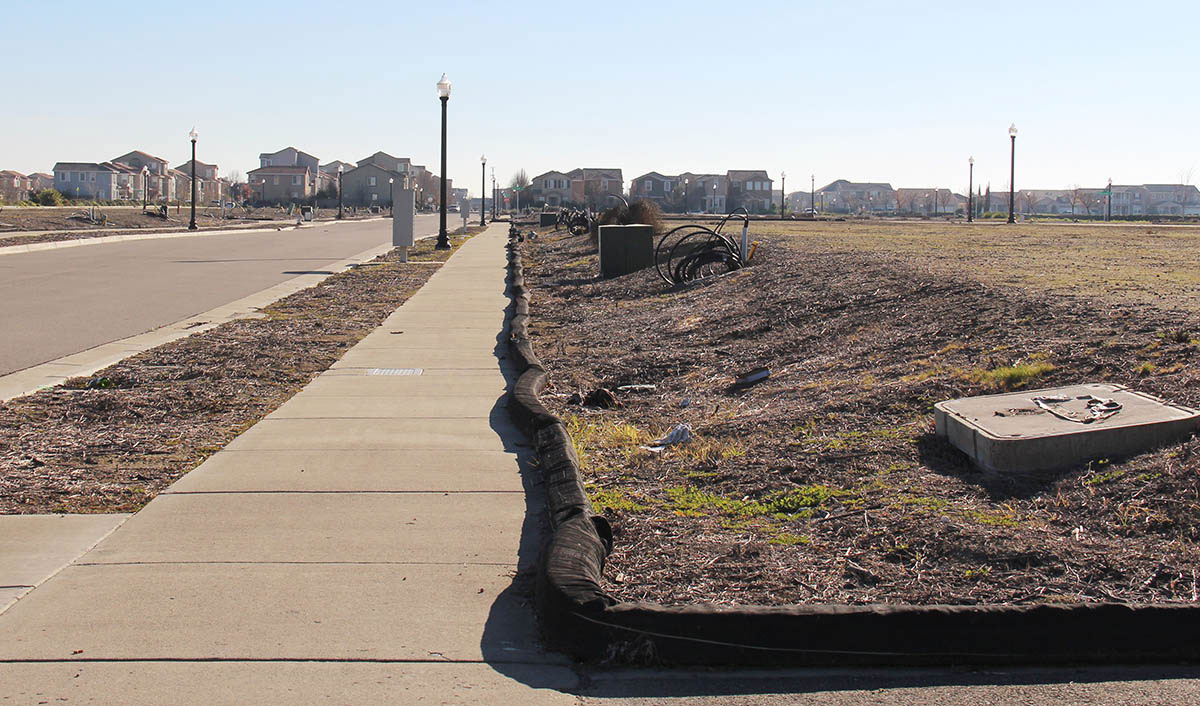Home>diy>Building & Construction>What Is A Construction Contingency


Building & Construction
What Is A Construction Contingency
Modified: January 3, 2024
Learn all about construction contingencies in building construction, including their purpose, importance, and how they mitigate risks to ensure project success.
(Many of the links in this article redirect to a specific reviewed product. Your purchase of these products through affiliate links helps to generate commission for Storables.com, at no extra cost. Learn more)
Introduction
Construction projects are complex undertakings that require careful planning, meticulous execution, and effective risk management. However, even with the most thorough planning, unforeseen circumstances can arise that impact the project timeline, scope, and budget. This is where a construction contingency comes into play.
A construction contingency can be defined as an additional amount of money or time set aside to address unforeseen events or changes during the construction process. It acts as a safety net, allowing for flexibility and adaptation in the face of unexpected challenges that may arise during construction. Contingencies are an integral part of project budgeting and play a crucial role in successful construction project management.
Construction contingencies are typically expressed as a percentage of the overall project cost. The specific percentage allocated to contingency varies depending on the nature of the project, the level of uncertainty, and the experience of the project team. Contingency funds can be used to cover various unexpected costs, including design changes, material price fluctuations, labor shortages, weather delays, and unforeseen site conditions.
The purpose of a construction contingency is to mitigate risks and provide a buffer for the project team in case of unexpected events. It allows for flexibility and adaptability, minimizing the impact of unforeseen circumstances on the project timeline and budget. By having a contingency in place, construction projects can proceed smoothly, and potential risks can be managed effectively.
Determining the appropriate amount of contingency for a construction project involves careful consideration of various factors. These factors include the project’s complexity, the level of uncertainty, the track record of the project team, the site conditions, and the regulatory environment. Each project is unique, and the allocation of contingency should be tailored to the specific circumstances and risks involved.
Managing and allocating the construction contingency requires a disciplined and systematic approach. It is essential to establish clear protocols for approving the use of contingency funds and ensure proper documentation of expenses. Regular monitoring and reporting are crucial to track the utilization of contingency and assess its impact on the overall project budget. Effective communication among project stakeholders is also essential to avoid misunderstandings and ensure transparency in the contingency management process.
The construction contingency plays a vital role in the overall success of construction projects. It helps to provide a level of certainty and reduces the potential disruptions due to unforeseen events. Contingencies provide project teams with the necessary resources and flexibility to tackle unexpected challenges without compromising the project’s quality, schedule, or budget.
In the following sections, we will explore real-world case studies where construction contingencies were effectively utilized, the challenges associated with implementing contingency plans, and best practices for managing contingencies in construction projects.
Key Takeaways:
- Construction contingencies are vital safety nets that provide flexibility and resilience in the face of unforeseen events, ensuring project success within budget and timeline.
- Thorough risk assessment, clear protocols, and transparent communication are essential for effective construction contingency management, enabling project teams to navigate uncertainties with confidence.
Read more: What Is Contingency Cost In Construction
Definition of Construction Contingency
A construction contingency is an additional amount of money or time set aside in the project budget to account for unforeseen events or changes that may occur during the construction process. It serves as a buffer or safety net to handle unexpected circumstances that could impact the project’s cost, timeline, or scope.
Contingencies are a common practice in the construction industry and are embedded in project budgets to provide a financial cushion and flexibility when faced with unforeseen risks. The contingency amount is typically expressed as a percentage of the total project cost and can vary depending on the nature of the project and the perceived level of uncertainty.
The primary purpose of a construction contingency is to manage and mitigate risks. Construction projects are inherently complex and involve numerous variables that can disrupt the original plan. Unforeseen events such as design changes, material price fluctuations, labor shortages, weather delays, or unexpected site conditions can impact the project’s progress and result in additional costs. A contingency fund provides project teams with the means to address these unexpected challenges without jeopardizing the project’s success.
Construction contingencies are allocated based on careful analysis and evaluation of various factors. Project complexity, level of uncertainty, past experience of the project team, site conditions, and regulatory requirements are among the key considerations in determining the appropriate contingency percentage. The goal is to strike a balance between having enough contingency funds to cope with potential risks and not overburdening the project budget unnecessarily.
It is important to note that a construction contingency should not be misconstrued as a slush fund or an invitation for budgetary laxness. Contingency funds are intended to be used for legitimate project-related expenses that are beyond the initial scope or estimates. Proper protocols and approvals should be in place to ensure that contingency funds are utilized judiciously and in accordance with project needs.
The management and allocation of construction contingency require careful planning and monitoring. Clear guidelines should be established on when and how contingency funds can be accessed. Regular analysis and reporting are necessary to track the utilization of the contingency funds and assess their impact on the project’s overall budget. Transparency and documentation of expenses related to contingency use are essential to maintain accountability and ensure that the funds are used responsibly.
Overall, the construction contingency serves as a vital risk management tool in construction projects. It provides project teams with the necessary resources and flexibility to adapt to unforeseen challenges and changes during construction. By having a contingency in place, construction projects can navigate potential risks with confidence, ensuring that they stay on track and within budget.
Purpose of Construction Contingency
The purpose of a construction contingency is to provide a financial buffer and flexibility to construction projects, allowing them to navigate unforeseen events and changes that may arise during the construction process. It serves as a risk management tool, helping to mitigate the impact of unexpected circumstances on the project’s timeline, budget, and scope.
Construction projects are complex and inherently prone to uncertainties. Despite careful planning and preparation, there are factors beyond the control of project teams that can disrupt the original project plan. These factors can include design modifications, material price fluctuations, labor shortages, weather delays, and unforeseen site conditions. The purpose of a construction contingency is to account for these uncertainties and provide the means to address them effectively.
One of the main purposes of a construction contingency is to ensure that a project can stay on track and maintain its schedule. Unforeseen events and changes in construction can cause delays, which can have a domino effect on subsequent project activities. By having a contingency in place, project teams have the necessary resources to respond quickly and mitigate the impact of unexpected delays. This helps to prevent further schedule disruptions and allows the project to maintain its timeline.
A construction contingency also serves to protect the project budget. Any unexpected events or changes in construction can result in additional costs. For example, a design change may require additional materials or labor. Fluctuations in material prices or delays caused by unforeseen site conditions can also increase project expenses. By having a contingency fund, project teams can access additional funds to cover these unforeseen costs, reducing the risk of budget overruns.
Additionally, a construction contingency provides project teams with flexibility and adaptability. The ability to respond to unforeseen events and changes in construction is crucial for the success of a project. Contingency funds provide the means to make necessary adjustments and modifications, allowing project teams to address challenges while minimizing disruptions to the project’s overall plan.
Furthermore, a construction contingency helps to instill confidence in project stakeholders. Owners, investors, and lenders are more likely to support a project that has contingency plans in place. It demonstrates that the project team has considered potential risks and has taken proactive measures to manage them. This gives stakeholders assurance that the project is well-prepared to handle unexpected events and changes, enhancing trust and credibility.
Ultimately, the purpose of a construction contingency is to safeguard the project’s success. It provides project teams with the means to navigate unforeseen challenges and changes without compromising the project’s quality, timeline, or budget. By having a contingency, projects can adapt and respond effectively to unexpected events, thereby increasing the likelihood of successful project delivery.
Factors Considered in Determining Construction Contingency
Determining the appropriate amount of construction contingency requires careful consideration of various factors. The contingency amount, typically expressed as a percentage of the total project cost, should be tailored to the specific project and its inherent risks. The following are some of the key factors that project teams consider when calculating and allocating construction contingency:
- Project Complexity: The complexity of a construction project plays a significant role in determining the contingency percentage. Complex projects, such as those involving intricate designs, advanced technologies, or unique site conditions, often carry higher inherent risks. These risks may necessitate a higher contingency allocation to account for potential challenges and uncertainties.
- Level of Uncertainty: The level of uncertainty surrounding a project is another key factor in contingency determination. Projects with higher levels of uncertainty, such as those with limited data or untested methodologies, may require a larger contingency to mitigate the unknowns. The more unknown or unpredictable factors involved, the greater the need for a contingency fund.
- Track Record of the Project Team: The experience and track record of the project team are important considerations in determining the contingency percentage. Teams with a proven track record of successfully managing similar projects and effectively mitigating risks may require a lower contingency allocation. Conversely, inexperienced teams or those with a history of cost or schedule overruns may warrant a higher contingency to account for potential risks and challenges arising from their lack of experience.
- Site Conditions: The site conditions can significantly impact the potential risks and uncertainties of a project. Projects located in geologically unstable areas, environmentally sensitive regions, or areas prone to extreme weather conditions may require a greater contingency. The possibility of encountering unforeseen site conditions, such as unstable soil or contaminated land, may necessitate additional funds to address any necessary remediation or modifications.
- Regulatory Environment: The regulatory environment in which the project operates is another factor to consider. Projects subject to extensive permits, approvals, or compliance requirements may face higher levels of uncertainty and potential delays. A contingency allocation should account for the additional time and costs associated with navigating regulatory processes.
It is important to note that these factors are not exhaustive, and each construction project is unique. The contingency allocation should be customized based on the specific circumstances and risks involved. Effective contingency determination requires a thorough evaluation of the project’s characteristics, risks, and potential challenges. This evaluation should be conducted by a knowledgeable project team and may involve input from professionals in various disciplines, such as engineering, finance, and risk management.
By carefully considering these factors and tailoring the contingency allocation accordingly, project teams can ensure that they have adequate financial reserves to address unforeseen events and changes, minimizing the impact on the project’s timeline, budget, and scope.
Allocation and Management of Construction Contingency
The allocation and management of construction contingency funds play a vital role in ensuring the effective utilization and control of these resources. Proper allocation and management strategies are essential to mitigate risks, maintain transparency, and maximize the benefits of the contingency fund. The following are key considerations for allocating and managing construction contingency:
- Establish Clear Approval Protocols: Clear protocols and guidelines should be established for accessing and utilizing the contingency funds. These protocols should outline the process for approving the use of contingency funds and specify the individuals or committees responsible for making these decisions. This ensures that the use of contingency funds is aligned with project goals and avoids misuse or unauthorized access.
- Document Expenses: Proper documentation of expenses related to the use of contingency funds is crucial for accountability and transparency. All expenses should be tracked and recorded, showing how and why the contingency funds were utilized. This documentation helps to maintain a clear audit trail and enables stakeholders to understand how the funds were allocated to address unforeseen events or changes.
- Regular Monitoring and Reporting: Contingency utilization should be closely monitored throughout the project’s duration. Regular reporting on the utilization of contingency funds is essential to track the effectiveness of the allocation and assess its impact on the overall project budget. Monitoring and reporting allow project teams to make informed decisions regarding the allocation of remaining contingency funds and potential adjustments to the project plan.
- Effective Communication: Communication among project stakeholders is crucial in managing the construction contingency. Key stakeholders, such as the owner, project team, contractors, and subcontractors, should have a clear understanding of the purpose and guidelines for utilizing contingency funds. Regular updates and communication channels should be established to keep stakeholders informed about the allocation and utilization of contingency funds.
- Risk Assessment and Contingency Review: Periodic assessments of project risks and the ongoing need for contingency funds should be conducted. As the project progresses, new risks may emerge, or existing risks may evolve, requiring adjustments to the contingency allocation. Regular reviews of the contingency plan allow project teams to evaluate the adequacy of the funds and make necessary adjustments to mitigate emerging risks.
- Control Budget Creep: While contingency funds serve as a safety net, it is important to manage them judiciously to avoid unnecessary budget creep. Contingency funds should be well-allocated, ensuring that they are used for legitimate project-related expenses that are beyond the initial scope or estimates. Strict control measures should be in place to prevent misuse or unwarranted access to contingency funds.
- Track Lessons Learned: Throughout the project, valuable lessons can be learned from the utilization of contingency funds. These lessons should be documented and shared within the project team to enhance future risk management strategies. By capturing and implementing lessons learned, project teams can improve contingency allocation and management processes for future projects.
Effective allocation and management of construction contingency funds require a disciplined and proactive approach. By establishing clear approval protocols, documenting expenses, monitoring and reporting, maintaining effective communication, conducting regular risk assessments and reviews, controlling budget creep, and leveraging lessons learned, project teams can optimize the utilization of contingency funds and minimize the impact of unforeseen events or changes on the project’s overall success.
Read more: What Does “Contingency” Mean In Construction
Importance of Construction Contingency
The importance of a construction contingency in construction projects cannot be overstated. This additional amount of money or time set aside to address unforeseen events or changes plays a vital role in ensuring the successful completion of projects. The following are key reasons why a construction contingency is important:
- Risk Mitigation: Construction projects are inherently risky endeavors. Uncertainties and unexpected events can arise at any stage of the project, potentially impacting the project’s timeline, budget, and scope. A contingency fund acts as a safety net, providing project teams with the means to mitigate these risks. By having contingency funds in place, project teams can proactively address unforeseen circumstances, minimizing their impact on the project’s progress and success.
- Flexibility and Adaptability: Construction contingencies provide project teams with flexibility and adaptability. They allow for adjustments and modifications when faced with unexpected events or changes. A dedicated contingency fund enables project teams to implement necessary measures without disrupting the overall project plan. This flexibility ensures that projects can adapt to unforeseen circumstances while staying on track and maintaining the project’s quality.
- Budget Protection: Construction contingencies help protect the project budget. Unexpected events or changes can result in additional costs, including unforeseen design modifications, material price fluctuations, labor shortages, or delays due to unforeseen site conditions. Without a contingency fund, these additional costs could lead to budget overruns. Having a contingency fund ensures that project teams have the financial reserves to address these unforeseen expenses, preventing budgetary constraints and maintaining financial stability.
- Schedule Assurance: Delays in construction projects can have significant ripple effects, impacting subsequent activities and leading to missed deadlines. A construction contingency allows project teams to address unforeseen delays promptly, ensuring the project stays on schedule. By having the necessary resources to mitigate delays, project teams can minimize disruptions and maintain the project’s timeline, avoiding costly setbacks and penalties.
- Stakeholder Confidence: Having a construction contingency instills confidence in project stakeholders. Owners, investors, and lenders are more likely to support a project that has contingency plans in place. It demonstrates that the project team has considered potential risks and has taken proactive measures to manage them. This level of preparedness increases stakeholders’ trust and confidence in the project, contributing to more robust support and collaboration.
- Unforeseen Risk Management: Construction contingencies allow project teams to address unanticipated risks effectively. While risks are identified and managed during the planning phase, unexpected events can still occur during construction. Contingency funds provide project teams the means to address these risks that were not initially foreseen. This proactive risk management approach reduces the likelihood of costly disruptions and ensures that the project remains on track.
In summary, a construction contingency is essential for successful project management. It mitigates risks, offers flexibility and adaptability, protects the project budget, assures the project schedule, instills stakeholder confidence, and enables effective management of unforeseen risks. By incorporating a construction contingency into project planning, project teams can navigate unexpected events and changes while minimizing their impact on the project’s overall success.
A construction contingency is a reserve of funds set aside to cover unforeseen expenses or changes in the scope of work during a construction project. It is typically calculated as a percentage of the total project cost and should be carefully managed to avoid unnecessary spending.
Case Studies: Successful Utilization of Construction Contingency
Real-world case studies provide valuable insights into the effective utilization of construction contingency funds. By examining these examples, we can learn from successful projects that navigated unforeseen challenges and changes through the astute allocation and management of contingency funds. The following are two notable case studies:
Case Study 1: The XYZ Office Tower
The XYZ Office Tower project encountered unforeseen delays due to unexpected soil conditions discovered during the excavation phase. The project team had allocated a construction contingency of 5% to account for potential risks. The utilization of this contingency proved instrumental in minimizing the impact of the soil conditions on the overall project schedule and budget.
With the contingency funds, the project team promptly engaged geotechnical experts to assess the site conditions and determine the necessary remediation measures. The additional costs associated with the soil stabilization efforts were covered by the contingency funds, ensuring that the project remained on track. Moreover, thanks to the proactive measures taken, the project team was able to avoid further delays and maintain the project’s timeline. The contingency allocation proved to be an essential resource in mitigating the risks posed by unforeseen soil conditions.
Case Study 2: The ABC Hospital Expansion
The ABC Hospital Expansion project faced a major design change during the construction phase, requiring extensive modifications to the mechanical and electrical systems. Recognizing the potential impact on the project’s budget and timeline, the project team had allocated a construction contingency of 10% to address unexpected design changes.
With the availability of contingency funds, the project team quickly engaged the necessary design professionals and contractors to implement the required modifications. The contingency allocation significantly mitigated the financial burden associated with the design change, covering the additional costs incurred by the revisions. This proactive approach enabled the project to adapt to the new design requirements without compromising the project’s budget or schedule. The effective utilization of the contingency funds ensured a successful completion of the ABC Hospital Expansion project.
These case studies highlight the importance of construction contingency in effectively managing unforeseen events and changes. They demonstrate how contingency funds can be strategically utilized to overcome unexpected challenges without derailing the project. By having a well-allocated contingency, project teams can navigate uncertainties, adapt to changes, and maintain project success.
It is worth noting that the success of these case studies was not just attributed to the availability of contingency funds but also to the proactive management and decision-making throughout the projects. Transparent communication, timely assessments, and rigorous documentation of expenses were key factors in the effective utilization of the contingency funds.
These case studies serve as valuable examples for project teams to understand the importance of constructing contingencies and the potential benefits they can provide when managed effectively. By learning from these successful utilization examples, project teams can enhance their risk management strategies and improve their overall project outcomes.
Read more: What Is A Home Inspection Contingency
Challenges in Implementing Construction Contingency
The implementation of construction contingency funds can present various challenges that project teams must overcome to ensure their effective utilization. Understanding these challenges is crucial for project managers and stakeholders to develop strategies for mitigating potential risks. The following are common challenges associated with implementing construction contingency:
- Uncertainty and Forecasting: Forecasting the exact amount of contingency needed can be challenging, as it requires predicting future risks and potential changes accurately. Uncertainties around project scope, site conditions, and market factors can make it difficult to determine the appropriate contingency allocation. Accurate risk assessments and regular monitoring are essential to reduce uncertainty and make informed decisions about the utilization of contingency funds.
- Availability of Contingency Funds: The availability of contingency funds can be a challenge, especially for projects with limited budgets or cost constraints. Allocating sufficient contingency funds without jeopardizing the overall project budget can be a delicate balance. Stakeholders must understand the importance of having adequate contingency funds and be willing to allocate the necessary resources to mitigate potential risks and challenges.
- Scope Creep: Scope creep refers to the gradual expansion of project requirements beyond the original scope. Uncontrolled scope creep can erode the utility of contingency funds, as unforeseen changes may exceed the allocated budget. Vigilant project management and strict change control processes are crucial in preventing scope creep and ensuring that changes are evaluated and approved within the confines of the contingency allocation.
- Decision-Making Process: Determining when to access and utilize contingency funds requires careful decision-making. Project teams must establish clear protocols and approval processes to ensure the proper use of contingency funds. Delays or inefficiencies in the decision-making process can hinder the timely response to unforeseen events, negatively impacting the project’s progress and budget.
- Proper Documentation: Keeping thorough and accurate documentation of expenses related to contingency funds can be challenging, but it is vital for accountability and transparency. Proper documentation ensures that the utilization of contingency funds is well-documented, auditable, and aligned with project needs. Challenges may arise when there is a lack of discipline in tracking and recording expenses, which can lead to potential confusion or disputes.
- Changing Stakeholder Expectations: Stakeholders’ expectations can change throughout a construction project, especially when issues arise that necessitate the use of contingency funds. Managing stakeholder expectations and providing regular updates on the utilization of contingency funds is essential to maintain transparency and mitigate any potential misunderstandings or conflicts.
Addressing these challenges requires proactive project management, open communication, and a disciplined approach to contingency allocation and utilization. Regular risk assessments, accurate documentation, clear decision-making processes, and effective stakeholder management are key components in overcoming these challenges and ensuring the successful implementation of construction contingency funds.
By being aware of these challenges and implementing appropriate strategies to mitigate them, project teams can optimize the utilization of construction contingency funds and maintain project success in the face of unforeseen events and changes.
Best Practices for Managing Construction Contingency
Effective management of construction contingency funds is crucial for project success. Implementing best practices ensures that these funds are allocated and utilized efficiently, mitigating risks and addressing unexpected events or changes. The following are key best practices for managing construction contingency:
- Thorough Risk Assessment: Conduct a comprehensive risk assessment during the project planning phase to identify potential risks and uncertainties. This assessment should consider factors such as project complexity, site conditions, and regulatory requirements. Thorough risk identification and analysis enable better allocation of contingency funds based on specific project risks.
- Establish Realistic Contingency Allocation: Set aside an appropriate amount of contingency based on the project’s unique characteristics. This allocation should consider factors such as project complexity, the level of uncertainty, and the experience of the project team. Avoid overestimating or underestimating the contingency amount, as it can negatively impact the project’s budget and risk management capabilities.
- Develop Clear Protocols: Establish clear protocols and guidelines for accessing and utilizing contingency funds. Clearly define the decision-making process and the roles and responsibilities of individuals involved in contingency fund management. This ensures transparency, accountability, and consistency in the utilization of contingency funds.
- Maintain Effective Documentation: Thoroughly document all expenses related to the utilization of contingency funds. Keep detailed records of the specific costs, justifications, and outcomes of each expenditure. Proper documentation assists in auditing, tracking, accountability, and transparency, providing a clear audit trail of how the contingency funds were utilized.
- Regular Monitoring and Reporting: Continuously monitor the utilization of contingency funds throughout the project. Prepare regular reports to track and assess the impact of contingency expenditures on the overall project budget. These reports facilitate informed decision-making and enable timely adjustments to the contingency allocation if necessary.
- Communicate Effectively: Maintain open and transparent communication regarding the utilization of contingency funds. Regularly update project stakeholders on the status, utilization, and impact of the contingency funds. Effective communication builds trust and ensures that all stakeholders are informed and aligned with the project’s risk management strategies.
- Review and Adjust as Needed: Conduct periodic reviews of the contingency plan to assess its effectiveness. As the project progresses, evaluate the remaining contingency funds, compare them against anticipated risks, and make adjustments if needed. Flexibility and adaptability are key in ensuring that the contingency plan remains responsive to evolving project conditions and challenges.
- Learn from Experience: Document and analyze lessons learned from past projects and the utilization of contingency funds. Capture insights and best practices to improve future risk management strategies. Continuously learning from experience enhances the effectiveness of contingency management in future projects.
- Collaborate with Key Stakeholders: Engage project stakeholders, including the owner, contractors, and subcontractors, in the contingency management process. Seek their input, feedback, and insights to ensure that the contingency planning aligns with project goals and expectations. Collaboration enhances ownership and buy-in, fostering a collective effort to effectively manage contingencies.
By following these best practices, project teams can successfully manage construction contingency funds, optimizing their utilization and minimizing risks. Thorough risk assessment, realistic allocation, clear protocols, effective documentation, regular monitoring and reporting, transparent communication, review and adjustment, learning from experience, and stakeholder collaboration are essential for effective contingency management.
Implementing these best practices enables project teams to navigate unforeseen events and changes with confidence, ensuring project success within the allocated budget and timeline.
Conclusion
Construction contingencies are an essential component of successful construction project management. They provide project teams with the necessary resources and flexibility to navigate unforeseen events and changes, mitigating risks and ensuring project success. By allocating and managing contingency funds effectively, project teams can minimize the impact of unexpected circumstances on the project’s timeline, budget, and scope.
In this article, we have explored the definition and purpose of construction contingency. We have seen that it acts as a safety net, allowing for adaptation and resilience in the face of uncertain challenges. Construction contingencies are allocated based on various factors, including project complexity, level of uncertainty, track record of the project team, site conditions, and regulatory requirements.
We have also discussed the importance of construction contingency, highlighting its role in risk mitigation, budget protection, schedule assurance, stakeholder confidence, and proactive risk management. Construction contingencies provide project teams with the means to respond effectively to unforeseen events and changes, ensuring that projects stay on track and within budget.
Furthermore, we have examined case studies that demonstrate the successful utilization of construction contingency funds. These real-world examples emphasize the importance of contingency planning and effective management in achieving project objectives and minimizing disruptions. They serve as valuable insights for project teams, showcasing the positive impact of contingency funds when allocated and utilized strategically.
Moreover, we have identified challenges in implementing construction contingency and provided best practices for managing these funds. The challenges include uncertainty in forecasting, availability of contingency funds, scope creep, decision-making processes, proper documentation, and changing stakeholder expectations. By adhering to best practices such as thorough risk assessment, clear protocols, effective documentation, and regular monitoring, project teams can overcome these challenges and optimize the utilization of contingency funds.
In conclusion, construction contingencies play a critical role in successful construction project management. They enable project teams to proactively address unforeseen events and changes, maintaining project progress, budgetary control, and stakeholder confidence. By following best practices and implementing effective contingency management strategies, projects can navigate uncertainties with confidence and achieve their objectives.
It is important for project teams and stakeholders to recognize the value of construction contingencies and prioritize their proper allocation and management. With a robust contingency plan in place, construction projects can withstand unforeseen challenges, adapting and thriving in the ever-changing construction landscape.
Frequently Asked Questions about What Is A Construction Contingency
Was this page helpful?
At Storables.com, we guarantee accurate and reliable information. Our content, validated by Expert Board Contributors, is crafted following stringent Editorial Policies. We're committed to providing you with well-researched, expert-backed insights for all your informational needs.














0 thoughts on “What Is A Construction Contingency”